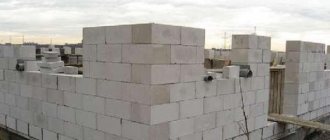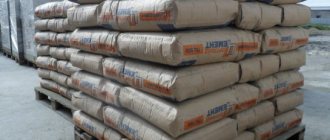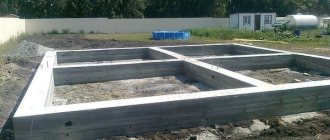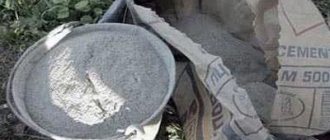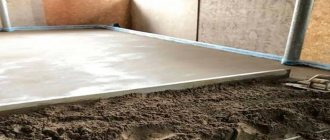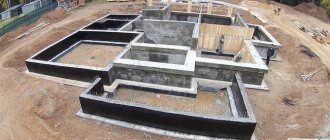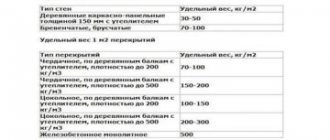*Explanations for the calculator
- The calculator can calculate the volume for both whole numbers and fractions. Example: concrete volume 3m3, concrete volume 50l (0.05m3).
- The calculator implements calculations for a mixture with mobility P3 (9-10 cm of cone slump) for cement-lime mortars (according to SP82-101-98). Water consumption for mixtures with different mobility is based on experimental batches. The mobility you need can be viewed in the “Mobility” field, which is automatically filled in when you select “Solution purpose”.
Current SNiP or old-fashioned method
The current rules give a fairly clear answer to the question of how much cement per cube of mortar may be needed. At the same time, calculations usually take into account not only the optimal volumes of components, but also their characteristics: fraction, purity, humidity, density, quality, etc.
When studying the norms of material consumption per cube of concrete, you should also take into account the conditions in which you plan to carry out the work. Thus, SNiP assume that concrete mixing and work are carried out at an ambient temperature of +23 degrees, under conditions of average humidity levels. All components must be clean and have a maximum moisture content of 7%.
Cement should only be taken fresh and just purchased, since its density may change during storage. Taking into account all these nuances, experts advise purchasing cement in volumes that are 10-15% higher than the norm.
How much cement is needed for 1 cubic meter of mortar:
- Cement grade M400 - for mortar M200 - 490 kilograms
- Cement grade M500 - for mortar M200 - 410 kilograms
- Cement grade M400 - for mortar M150 - 400 kilograms
- Cement grade M500 - for mortar M150 - 330 kilograms
In the tables you can find the following data:
When preparing concrete, it is important to calculate how much crushed stone and sand is needed per 1 m3 of solution, since the strength, reliability, durability of the monolith and other important characteristics depend on these components.
The table shows the consumption of sand and crushed stone:
When preparing concrete, you should remember that everything can be calculated based on the total weight of a cubic meter of solution. But that's not true. Given that the cement is extremely finely ground and fills the voids between the sand grains, it may not increase the overall volume of concrete. So, by adding 200 or 400 kilograms of cement, the volume of solution (1 cubic meter) is obtained the same.
Water is added to the mixture in an amount equal to half the mass (but not volume) of cement. The moisture content of the sand must be taken into account - the wetter the sand, the less water will be needed. It is best to pour water in portions and look at the consistency: when it reaches the required thickness, the concrete will be ready for use.
Regardless of the brand of concrete, its consistency should be optimal for the job. According to the standards, consistency is determined by the amount of sediment of a metal cone, which is dipped into the solution.
But, as a rule, in construction conditions it is not possible to use this method. Therefore, it is usually determined visually: the thickness of the solution should be sufficient for comfortable installation (pouring), leveling, and retention in joints and formwork.
Algorithm for calculating the composition of a solution
Selection of solution composition for 1 m3 of sand
To implement the calculator, the data and calculation algorithm were taken from:
SP82-101-98: Preparation and use of mortars GOST 28013-98: Construction mortars. General technical conditions
1. Determine the consumption of binder (cement) per 1 m3 of sand depending on the selected brand of mortar and brand of cement.
We determine the cement consumption per 1m3 of sand using the formula:
2. Determine the volume of lime per 1 m3 of sand using the formula:
where Qв
– consumption of binder (cement) per 1 m3 of sand, kg
Vd
– inorganic additive (lime) per 1 m3 of sand, m3.
We determine the mass of lime per 1m3 of sand using the formula:
Qd = Vd * λ;
where Qd
– consumption of additive (lime) per 1 m3 of sand (kg);
λ
– bulk density of additive (lime) kg/m3;
3. We make up the proportion of the volumetric parts of the solution
You can also use the table of ready-made proportions in volumetric ratios (Table 4 SP82-101-98)
4. Determine the water consumption per 1 m3 of sand.
The approximate water consumption in SP82-101-98 is shown for a mixture with mobility P3 (9-10 cm depth of cone settlement). This mobility according to GOST 28013-98 is suitable for masonry made of solid bricks and ceramic stones. Water consumption for other mixture mobility is determined as a result of trial batches. We can select the mobility we need depending on the purpose of the solution using the table presented in GOST 28013-98
Calculation of materials per 1m3 of solution
An example of counting materials for 1 batch and for 1 m3 of solution is shown in Appendix A SP82-101-98.
For floor screed
Excerpts from the Recommendations for the installation of floors (to SNIP 3.04.01-87 “Insulating and finishing coatings”)
Appendix 1 Table 4
GOST standards, books, programs and calculators for calculating the composition of the solution
SP82-101-98: Preparation and use of mortars GOST 28013-98: Construction mortars. General technical conditions Recommendations for floor installation (to SNIP 3.04.01-87 “Insulating and finishing coatings”) Manual - mortars (example of calculation of materials for mortar)
Brick costs for 1m3 of wall
Cost calculations are based on block cost standards plus solution consumption per 1 m3 for products of different sizes.
To calculate the volume of the base, you should multiply the width, length and height of the structure, minus windows, doors and other voids: V = a ∙ b∙ c, where a is length, b is width, c is height.
How many building products will be needed and what will be the solution consumption per 1 m3 of a solid partition - approximate data are given in the table below:
| Variety of products | Material (measured in m3 and pcs.) | Wall thickness in cm | ||||
| 12 | 25 | 38 | 51 | 64 | ||
| Private | Blocks | 420 | 400 | 396 | 395 | 393 |
| Working mixture | 0,19 | 0,22 | 0,235 | 0,25 | 0,246 | |
| Modulated | Blocks | 32 | 309 | 295 | 295 | 293 |
| Working mixture | 0,17 | 0,21 | 0,215 | 0,22 | 0,228 | |
For building block sizes:
- Single: 250 mm x 120 mm x 65 mm;
- One and a half: 250 mm x 120 mm * 88 mm;
- Double: 250 mm x 120 mm x 138 mm.
How to calculate the number of units for a plinth?
Having previously calculated the volume of the entire wall, it will be easier to calculate the number of block products per plinth.
Operating principle: the volume of the base is determined, and the result is divided by the volume of one ordinary product. The result will be the number of blocks needed to build the basement wall.
In the same way, you can calculate the facing base.
| Variety | Thickness | |||||
| Half a brick (12 cm) | One (25 cm) | One and a half (38 cm) | Two (51 cm) | Two and a half (64 cm) | ||
| Ordinary size 250 x 120 x 65 mm | Building block (pcs.) | 420 | 400 | 395 | 395 | 393 |
| Mix (m3) | 0,19 | 0,22 | 0,235 | 0,240 | 0,245 | |
| Modulated with dimensions 250 x 120 x 88 mm | Building block (pcs.) | 320 | 309 | 295 | 294 | 293 |
| Mix (m3) | 0,17 | 0,21 | 0,215 | 0,22 | 0,228 | |
Consumption rates for different solutions
Depending on what concrete is needed for, 1 m3 of solution may contain different volumes of cement. In modern construction, concrete mortar is used to carry out four tasks: pouring the foundation, laying building blocks, pouring screed and performing plaster. For each of these types of work, it is assumed that a certain type of mortar with a specified volume of cement will be prepared.
The highest consumption of cement per cube of mortar is obtained when preparing a mixture for masonry or plaster. When pouring a foundation or screed, it is important to use large fillers (gravel, crushed stone, slag), which reduces cement consumption. The purpose of the solution is indicated by the brand (the properties of concrete and the main characteristics depend on it).
Calculation of cement per cube of concrete according to GOST:
- M100 – 170 kilograms of cement
- M150 – 200 kilograms
- M200 – 240 kilograms
- M250 – 300 kilograms
- M300 – 350 kilograms
- M400 – 400 kilograms
- M500 – 450 kilograms
For plaster
A standard plaster solution is prepared from 3 parts sand and 1 part cement. If the layer is made with a thickness of no more than 12 millimeters, then 1.6 kilograms of M400 cement and 1.4 kilograms of M500 cement are weighed per 1 square meter of plaster. The volume of mortar per cubic meter of masonry can be calculated as follows: 1 m2 x 0.012 m = 0.012 m2 = 12 liters.
On masonry
For a square meter of brickwork one brick thick, you will need at least 75 liters of M100 mortar. The proportion of M400 cement and sand is 1:4. Thus, the cement consumption for bricklaying is 250 kilograms per cubic meter of sand. How many cubic meters of solution will be needed in total is calculated based on the size of the building.
Water is taken in a volume equal to half the weight of cement. So, if you mix the solution using buckets, it turns out like this: 1 bucket of M500 cement, 4 buckets of sand, 7 liters of water.
For the foundation
To prepare a solution for pouring the foundation, you need to calculate everything correctly. Typically, a solution of grade M100-M300 is used. The strength of M100 is sufficient for low-rise buildings, M150 and M200 are suitable for buildings of several floors. The higher the grade, the stronger the structure will be. For mixing, take cement M300/M400 (1 part binder and 3 parts sand) or M500 (1 part binder and 5 sand).
Cement consumption per cubic meter of solution:
- M50 (based on M400 cement) – 380 kilograms
- M100 (based on M300 cement) – 214 kilograms
- M200 (based on M400 cement) – 286 kilograms
- M300 (based on M500 cement) – 382 kilograms
Such calculations are relevant if the mixture is prepared according to the following proportions: 1 part cement, 2-4 parts sand, 3 parts crushed stone/gravel.
For screed
The proportion for mixing is as follows: 1 part cement and 3 parts sand. Here you can give an example of correct calculations. So, you need to fill a surface of 3 by 4 square meters (12 is obtained) with a layer thickness of 30 millimeters.
Calculation steps:
- Determining the required volume of concrete solution: 12 m2 x 0.03 m = 0.36 m3.
- Choosing a brand of concrete - take M200, prepare it from M500 cement, which requires 410 kilograms.
- Calculation of the number of bags of cement: 410 kg x 0.36 m3 = 148 kg / 50 = 3 bags (almost).
- How much sand is needed: 1600 kg/m3 (weight of a cubic meter of mixture) x 0.36 m3 (required amount of mixture) = 576 x 0.75 (proportion of sand in concrete) = 432 kilograms. A cube of sand solution will take about 1200 kilograms.
